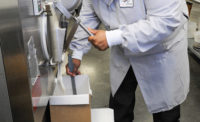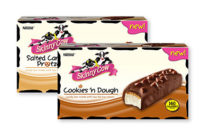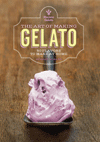Meet the rock stars of Comfy Cow ice cream

Roy and Tim Koons-McGee want customers to see The Comfy Cow ice cream parlors as places to hang out with family and friends. This store is in Louisville’s Clifton neighborhood.

For their business to grow, the founders knew they need individuals with skill sets different from their own. The management team includes (front row, from left): VP of Production Gary Steele, VP of Sales Austin McCown, Founder Tim Koons-McKee and Founder Roy Koons-McGee. Standing (from left): General Counsel Nelea Abshear, Comptroller Brad Beard, Marketing Director Barnett Edelen, Director of Home Place Fran Berg and CEO Don Berg.

In Louisville’s Bardstown neighborhood, Adam Brown offers a generous serving of ice cream. The stores also sell ice cream cakes, pies and novelties.

Thank-you cards and community notices cover a board in The Comfy Cow ice cream parlor in Bardstown. When founders Roy and Tim Koons-McGee show up at a store, regular customers greet them like rock stars, says CEO Don Berg.




Geography is destiny. Detroit is the Motor City. California has its high-tech Silicon Valley. Louisville, Ky., has been successful with food. Yum!Brands (KFC, Pizza Hut and Taco Bell) makes its headquarters downtown, along with Brown-Forman (Jack Daniels, Finlandia), Papa Johns, Long John Silver’s and Texas Roadhouse. These companies attract suppliers, talented individuals and investors. More than 125 food and beverage companies are located in the region and they generated $23 billion in annual revenues, according to Louisville Forward, a development arm of the city government.
When the two founders of a growing ice cream company in Louisville needed management talent and investment dollars, they happily found themselves in the right place. Tim and Roy Koons-McGee started with one scoop shop in Louisville in 2009. They made ice cream and baked goods in a back room. One store led to opening three more. When Whole Foods wanted to carry pints, the co-founders knew they had maxed out their skill sets and their manufacturing capacity.
“It became obvious pretty early on that Roy and I needed help,” Tim said. “We both have our strengths. And you don’t get to be my age without knowing what you know and what you don’t know, what you are good at and what you are not good at. So when we knew we wanted to grow, we really looked for some outside help, somebody who had the experience and knowledge.”
Don Berg is a long-time Brown-Forman executive who was serving on the board of directors (and was an investor). He became the chief executive officer (also called “the head of the herd.”) Berg brought on Gary L. Steele to run the new manufacturing plant, built in part with a grant from the state. (see related article) Steele had experience setting up commissaries for Papa Johns throughout Eastern Europe and the Middle East. Berg then rounded out the management team with a controller, a marketing executive, a director of franchising and sales people.
Experience matters
In February, I sat down with Berg and the Koons-McGees at one of their stores in Louisville’s Clifton neighborhood. I asked Berg about what he learned at Brown-Forman that he is applying to The Comfy Cow. He told me he learned how to break into new markets, how the grocery store channel works and the importance of branding.
“For seven years I was responsible in some form or fashion for Brown-Forman’s initiative to get established in emerging markets,” Berg said. “So literally getting Jack Daniels into places for the first time and having to hire people and infrastructure, and putting together promotional plans to introduce the brand for the first time to consumers.”
He said that later in his career he was responsible for running the United States operations.
“And so that got me more closely associated with the grocery channel and how that works. From a branding standpoint there are so many similarities to selling super-premium ice cream to selling super-premium bourbon,” Berg said. “For example, they are both indulgences. On the Jack Daniel’s side of the equation consumers have learned that they need to drink in moderation and so they’ve created this whole mentality around, ‘If I’m going to drink, I’m going to drink really good spirits.’ You see the same thing in super-premium ice cream. With people being health-conscious, they still want really good things, but they’re going to do it less. So when they do it, they’re going to do it right.”
Berg took another page from Brown-Forman’s past: he entered a contest. A century ago, Jack Daniels won the 1904 St. Louis World’s Fair Gold Medal for whiskey, and that recognition became their mark of excellence. In 2015, The Comfy Cow entered several flavors in the World Dairy Expo Dairy Product Contest, sponsored by the Wisconsin Dairy Products Association. The Brown Butter Peanut Brittle ice cream was named the grand champion.
“What more could you ask for? It just authenticates everything,” Berg said. “We hoped to do well. We were really surprised and just humbled [when we won]. There were two things that struck me when I was up in Madison [to accept the award]. One was the number of people who said, ‘You have no idea what you’ve done. For a company to enter for the first time and win it all, that’s just unheard of.’ The other thing that really cracked me up was a couple of the judges said, ‘Who would have ever thought to put bourbon in ice cream?’ I thought, ‘You have obviously never been to Kentucky. We put bourbon in everything down here.’”
Besides the World Dairy Expo award, which recognizes technical excellence, the company also received consumer recognition from the website BuzzFeed, which called The Comfy Cow one of “27 Ice Cream Shops You Need To Visit Before You Die.”
The founders are ‘rock stars’
Berg sees the role of The Comfy Cow founders as the face of the company, much like Bill Samuels who built Maker’s Mark bourbon. Berg called him “one of the legends around Louisville” who was “the ambassador for the brand.” He envisions something similar for the Koons-McGees.
“I see Tim and Roy, as we go down the road, to just be spokespeople for the brand. These guys are like rock stars in Louisville. They created this great ice cream that everybody loves. When people come in here (one of the scoop shops), I can’t tell you the number of people who will say, ‘I know the owner of the company.’ It just kind of comes with the territory.”
Tim Koons-McGee acknowledged that building up the management team has allowed him and Roy to “concentrate on being the face of the brand, promoting the brand, and telling our story.”
They now have time to explain “why is it worth spending a couple dollars extra to buy our ice cream? Well, here’s why, because here is what went into it. So our roles have really changed over the last year or so,” he said.
Tim, who grew up in York, Pa., said he suffers from “career ADD.” He graduated from Princeton University, dropped out of culinary school, did remodeling, trained thoroughbred horses and is a painter, among other jobs and interests. He met Roy, from Hopkinsville, Ky., who had a long career in healthcare. They married in October 2007. Tim likes to say he’s “the sizzle” and Roy is “the steak.”
“My strengths are more the brand building, [Roy] really is the operations. He is the nuts and bolts of it. I am out there promoting and shaking hands and thinking about how we sell more product,” Tim said.
Roy said Tim has “a lot of steak, too” but added that “as far as building the business, and really having the vision, that’s been more him. He’s this big thinker.”
To illustrate that point, Roy said the two once were sitting around a campfire and one said, “Wow, isn’t that amazing?” and the other agreed.” Roy was looking at the fire and Tim was looking up at the stars in the sky.
“We both had a different focus. He’s more of this grand guy looking out there and I’m more grounded,” Roy said.
Roy said his background in healthcare (first as a paramedic, later as an emergency room nurse and then in management) helps him put the ice cream business in perspective. He brings a cool head to situations that might be tense.
“If you run out of something, let’s not get too worked up. It’s just ice cream. Nobody’s dying or anything,” he said.
Roy also is a people person who pays attention to the staff. A store employee was impressed that Roy called her by name. That wasn’t the case at another food store she worked in, she said. The company has about 70 employees working in the plant and in the four company-owned stores. In the summer, employees grow to more than 100. Roy and Tim have also developed friendships with customers.
“We’ve made lots of friends over the years through this business, which I wouldn’t trade anything for,” Roy said. “With our first store, because we were there 24/7 working the line, we just became friends with people that would be regulars in the store. They’d invite us over to dinner or functions.”
A two-part growth strategy
Tim Koons-McGee said The Comfy Cow grew haphazardly. One store led to another and the company was selling to a few local restaurants. But there was no formal, written business plan. Today though, the path is clear. By the end of this year, the company aims to have product in 300 stores and 11 franchises. Longer-term, the goal is to be a national brand in packaged ice cream and in ice cream scoop shops, he said.
“We’ve got a dual strategy. We do think that our scoop shops are so experiential and they are different. They are kind of funky and fun and people like to hang out here. We wanted to create an atmosphere where a community could exist. You create community, so that has a lot to do with the brand itself. And we thought, if we could have scoop shops in certain areas of the country, it would help the retail, so it would help people get brand awareness and vice-versa,” he said.
“We believe that grocery and the retail scoop shops work hand in hand,” said Austin McCown, who heads up the franchising sales.
In February, the company had four stores in Kentucky, two franchises in Southern Indiana (across the Ohio River in Jeffersonville and New Albany) and a franchise in Brentwood, Tenn., a Nashville suburb. McCown’s pitch to potential investors is that a Comfy Cow franchise is something they can “work on, not work in. We feel like we have a playbook. If they follow the playbook, they’ve got an incredible business opportunity, and the ice cream is the best.”
Before becoming CEO, Berg and his wife had invested in the Brentwood store. He liked the concept because he said “a typical ice cream store generally is so sterile. It’s just somewhere to sit and eat your ice cream. I thought [Tim and Roy] were really brilliant in the way that they brought this whole thing together and made it so warm and inviting.”
A different sort of ice cream parlor
The décor is anything but traditional. Instead of hexagonal floor tiles and wire-backed chairs, The Comfy Cow stores have wood floors, pressed tin ceilings, upholstered sofas, child-size tables and chairs, and fireplaces.
When Tim describes the scoop shops as “experiential” he is talking about the physical space, the music playing in the store, the menu boards, the freezer, the rest rooms and the service. He designs the interiors, even the bathrooms. The men’s room in the Bardstown store is decorated with pairs of balls (tennis, golf, softball and similar sporting goods). Another bathroom is decorated with neck ties. A ladies’ bathroom is outfitted with purses and hand mirrors.
“I really enjoy it. I am a painter by nature and I don’t have any time to paint anymore, so this is kind of my canvas,” Tim said.
One wall of the store in Bardstown is plastered with paint brushes, which Koons-McGee said he found in an alley. “I thought, I’m going to do something cool with them.” Another example of design whimsy are the Barbie dolls poking through the ceiling of the Bardstown store.
Koons-McGee wants each store to become a local hang-out. Every store has space for community notices and thank you notes. Fan mail from customers (“We get a ton,” he said) is displayed throughout. The Comfy Cow invited local artists to display their work in one store.
“We really encourage our franchisees to do the same, to get involved in the community,” Koons-McGee said. “We are really big on giving back. We opened a store in Nashville. I had the AP art class (from the local high school) come over and paint a mural. It gives them some ownership of that space and makes it more Nashville.”
He describes the stores as “family friendly. It’s a place where families come in and hang out. We’re not trying to get them in and out the door. We want them to hang out and have fun and enjoy this place.”
Selecting a store location is based on four criteria: a population of at least 50,000 within three miles, a high per-capita income, a patio and parking availability, McCown said.
But it is the variety and the original ice cream flavors that make the stores successful. With more than two dozen flavors to choose from, first-time customers have a tough decision to make. Koons-McGee encourages the employees to offer samples. Simply offering a verbal description of the ice cream is not sufficient, he said.
“You might have a different perception than I would. And we both might have different palates. I’d still have you take a sample and make sure you like it. I don’t want you to spend the money and say, ‘Oh, it wasn’t very good.’ It’s not that it wasn’t very good, it was that you don’t like that flavor. So that’s always been a key component, to really get them to sample as many flavors as they can.”
Community ties
Besides being closely allied with the neighborhoods where the stores are located, The Comfy Cow also has become part of the manufacturing community. By sourcing materials made in the commonwealth, the ice cream maker receives a rebate through the Kentucky Proud program. The company also participates in the new Udderly Kentucky program (through Prairie Farms of Somerset), which guarantees that the milk comes only from Kentucky cows.
“We are really proud to be the only ice cream maker that is actually using Udderly Kentucky, which is 100% small farms in Kentucky. It makes an impact on those farmers,” Koons-McGee said.
The company gets together with other small food manufacturers in Louisville to talk about trends and ideas. (“It’s just fun to sit down with them and collaborate,” Koons-McGee said.) In February, for example, the company met with the owners of Bourbon Barrel Foods (a maker of soy sauces) and Cellar Door Chocolates (a retail chocolatier). From that meeting, Comfy Cow chef Erica Parker developed the idea for an ice cream made with togarashi, a popular Japanese spice mix made with chili peppers.
The Comfy Cow has come a long way in less than seven years. Koons-McGee remembers when the company did not own a freezer truck. He loaded up his Jeep with ice cream to deliver to a restaurant customer 15 minutes away. “I would drive as fast as I could. I would always pray that the train wasn’t stopped” on the tracks so the ice cream wouldn’t melt in transit, he said.
In the future, the founders see Comfy Cow stores throughout the Southeast and packaged ice cream in grocers’ freezers nationwide. When I asked Berg about weaknesses at the company, he said it is “really just a matter of being able to grow as fast as we can potentially grow. Just like any start-up company, you’re always scraping for those dollars and making sure that we’re hiring really good people that can create the kind of culture and environment that we’re really looking to create here. The opportunities are huge.”
He also said he sees an opportunity in food- or agri-tourism.
“Part of what we’re doing is rooting ourselves into Louisville. There’s such a whole bourbon thing going on here in terms of the Bourbon Trail. There’s an urban bourbon trail and so there’s a whole tourism aspect of this that I think just lends itself for us to dial into.”
With a nation obsessed with food, especially high-quality and artisan-made food, The Comfy Cow is well-positioned for long-lasting success.
Looking for a reprint of this article?
From high-res PDFs to custom plaques, order your copy today!













